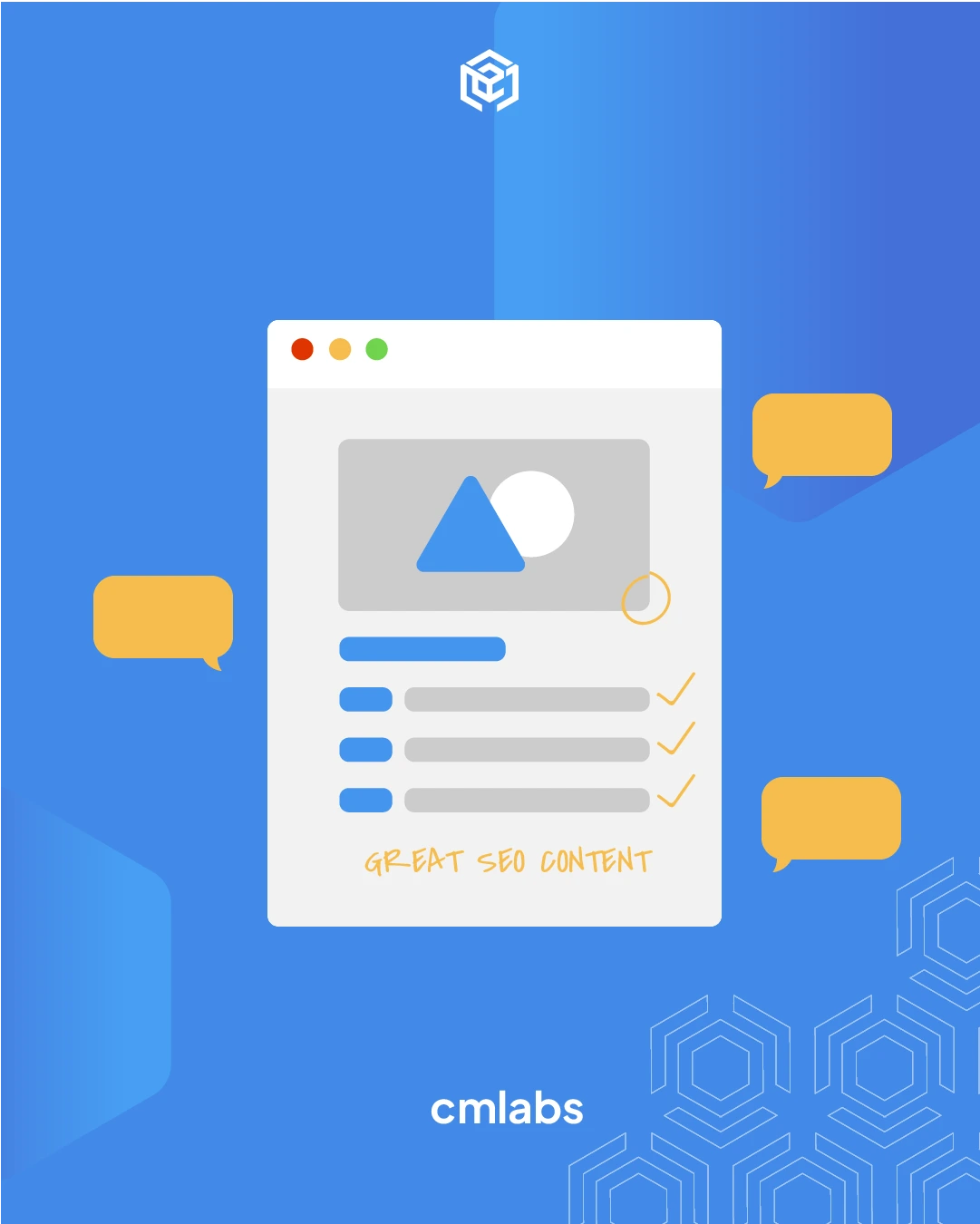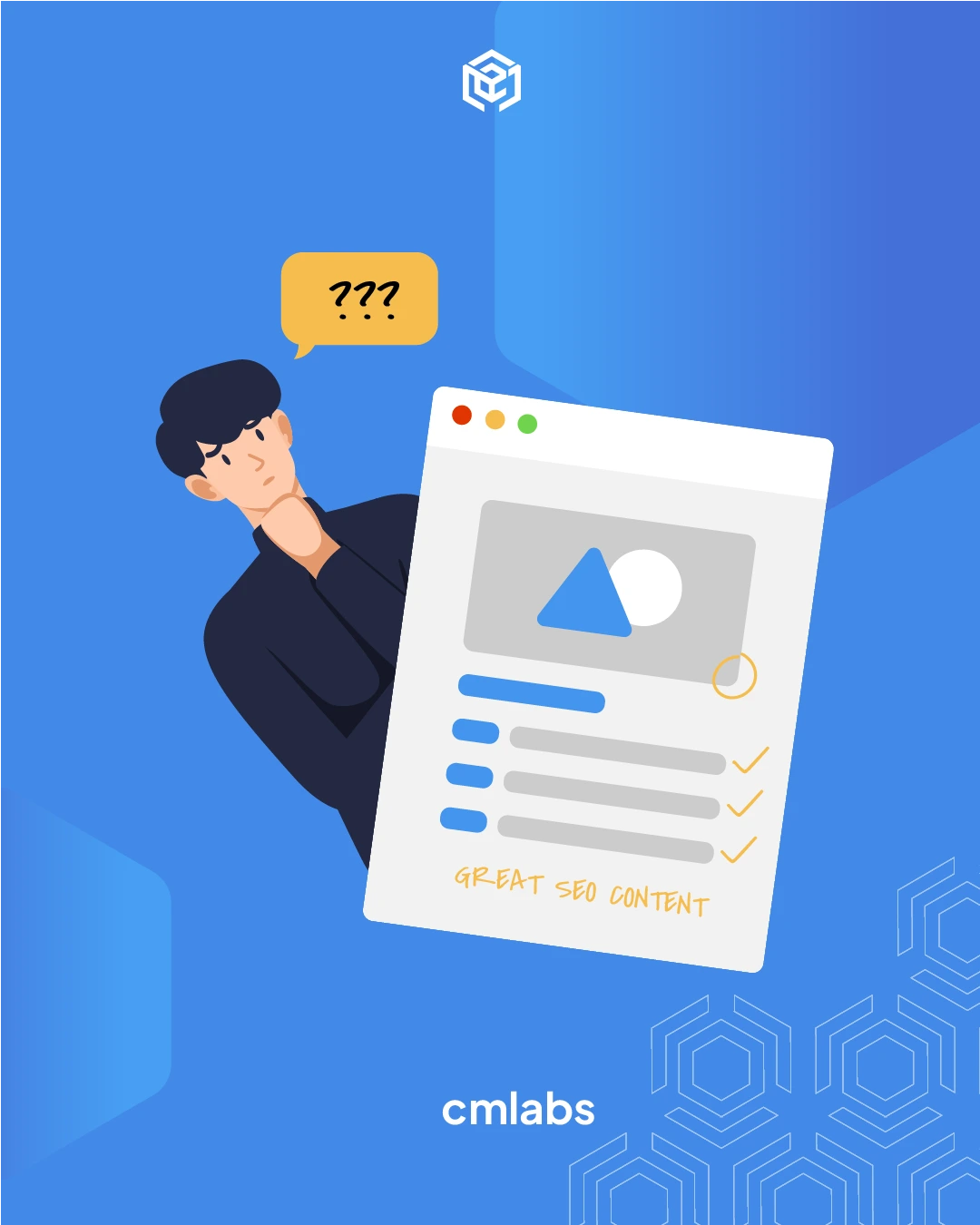We use cookies
This site uses cookies from cmlabs to deliver and enhance the quality of its services and to analyze traffic..
SEO SERVICES
Conduct in-depth technical website audits, strategically develop website projections, and increase your website authority.
ASO SERVICES
Elevate Your App’s Presence with Our Expert ASO Services – Boost Visibility and Drive Downloads!
WRITING SERVICES
We offer a variety of writing services to suit different business necessities. Reach broader audiences or lead specific industries? We've got you covered!
SEOlutions
A unified source of truth!
SEO & Digital Maternity Solution
SEO & Digital Maternity Solution: Leverage Cross-Platform Insights to Elevate Your Strategy with Expert Consultation
SEO & Digital Maternity Solution
Data Solution options:
Starting from Rp200 mio
Reinventing how a company get creative treatments
A new way to get your creative needs done. Agile team, efficient cost, and expedient way in a flexible yet scalable subscription plan!
Creative-as-a-Services
CaaS package options:
Based on Subscription
Pioneer in digital marketing software powerhouse
We’re excited to unveil our new range of Tech Solutions designed to drive your digital success. Whether you’re looking to enhance your website’s performance, streamline your tech stack, or unlock deeper insights from your data, we’ve got you covered.
Starting from Rp250 mio
Our Clients
Research and innovation center for digital transformation
Digital marketing combines technical skills and business knowledge at every stage. For marketing teams, improving budget management efficiency is crucial, as time is an invaluable resource that should be used wisely. At Sequence, we are dedicated to empowering you to optimize efficiency and strategic planning, ultimately enhancing the impact of your digital marketing efforts.
Subscription-based (IDR1,800/keyword)
Our Clients
BeyondSEO
References
SEO Tools for Webmasters
SEO Tools for Writers
SEO Tools
FIND THE SUITABLE PARTNERSHIP FOR YOUR COMPANY
Check out which cmlabs partnership program suits your company
WHITE LABEL SEO
for CorporateYour company is granted exclusive partnership rights to provide SEO services to our important clients, and we will provide a dedicated backend team to support your efforts.
AFFILIATE PROGRAM
for BizdevA new affiliate program is being introduced for skilled marketers and individuals with strong networks, offering commissions of up to 7% for generating profits independently.
DIGITAL AGENCY
for Marketing Partnerscmlabs is an essential partner for digital agencies, providing a unique selling proposition in Search Engine Optimization (SEO).
BACKLINK PARTNERSHIP
for Media / BloggerWe have a vast database of bloggers and media outlets across Indonesia, categorized by region and media type, giving our clients an edge in managing their media and SEO activities.
OFFICIAL TRAINING
We provide ongoing professional development and support to SEO professionals to ensure they are equipped to meet market demands.
JOIN AS CONTRIBUTOR
for Content WriterGreat opportunity for SEO Writers around the world. T&C applied!
ACADEMIC PARTNERSHIP
Through partnerships with universities in Indonesia, cmlabs has helped align academic curricula with industry demands.
Partnership
Sector & Industries
Tell us your SEO needs, our marketing team will help you find the best solution
As an alternative, you can schedule a conference call with our team
Schedule a Meeting?Contact
Survey
We use cookies
This site uses cookies from cmlabs to deliver and enhance the quality of its services and to analyze traffic..
Last updated: Dec 11, 2023

A Minimum Viable Product or MVP is a beneficial strategy in the product design process, especially for startup companies.
In an easier context, it is a new product with simple features designed to meet the basic needs of potential customers.
The concept of the Minimum Viable Product was first introduced through the book "The Lean Startup" by Eric Ries.
According to Eric, an MVP is a product specifically designed to attract attention, ensure approval of the business idea, serve as a means to gather product-related feedback and conduct testing for customer experience. The Minimum Viable Product is a crucial part of the product development process.
This product concept prioritizes simplicity of features but with significant functionality and value, allowing businesses to provide products that meet customer needs with minimal risk.
Learn more about what is MVP, its purposes, and examples in the following review!
Before releasing a product, a brand needs to validate assumptions, collect user feedback, and analyze whether a product has the potential to succeed in the market.
By implementing the Minimum Viable Product, these goals can be achieved without the need for large-scale resource expenditure. The objectives include:
After a product has been designed and is ready for release, the digital marketing team will conduct A/B testing to test two or more variables and ensure that the released product is the best version.
Both MVP and A/B testing share the same goal of simplifying the product testing process to reach consumers sooner. However, to test the product directly with users, Minimum Viable Product is the right step to obtain real product feedback.
The presence of the Minimum Viable Product is highly needed by startups, especially to meet production needs at critical moments.
With this kind of product, startups can release a basic version of the product faster than a complex and time-consuming final version.
These viable products can also help startup businesses understand market trends and needs, obtain user feedback earlier, and make necessary changes as soon as possible.
With simple and basic features in the Minimum Viable Product, you can learn the needs and expectations of potential customers, allowing you to perfect the final product.
By introducing a product with simple yet fundamental features, you not only minimize the financial and operational risks associated with a full-fledged product launch but also gain invaluable insights into the needs and expectations of your potential customer.
When it comes to managing a company's financial resources, the importance of cost-saving measures cannot be overstated.
In this case, creating a Minimum Viable Product is the right solution for companies trying to save on their business budget.
By providing a simple product, you can already receive feedback from potential customers without requiring additional costs.
As mentioned earlier, this concept often used to test innovations or plans with minimal budget and risk. Here are some key characteristics you should learn.
In the business world, there are several types of viable product commonly used to attract the attention of potential customers. Explore those types below:
Now that you understand what is MVP product, you should also learn about how to create a Minimum Viable Product to trim down your business production expenses.
The first step is conducting market research. This research aims to ensure that your product meets the needs of the target market.
To do this, you can conduct surveys, analyze target audience databases, and thoroughly research competitor products. You can also perform research such as:
You don't need to make your product as perfect as possible. Instead, focus on providing solutions, added value, a unique selling proposition (USP), and business value in line with what consumers need.
Based on the market research conducted earlier, concentrate on addressing user opinions, desires, or expectations in product development to make it even better. Consider to tailored to the target market's problems to highlight the solution provided by your product.

Another crucial aspect is determining your business's value proposition. With this value proposition, you can test whether the developed product can meet the needs or demands of potential customers in terms of features, benefits, and user experience.
You also need to master the step-by-step stages that your target audience must go through in the marketing funnel before making a purchase.
From efforts to increase brand awareness, interest, and consideration, to purchase, all aspects should be thoroughly analyzed in advance.
Once you've understood the needs of the target audience and potential customers, you need to ensure that this MVP product can solve the problems faced by potential customers.
So, how do you do that? You need to create hypotheses based on the capabilities and to what extent the product incorporates the following characteristics:
Once the above testing is completed, it's time for you to release the product. Before doing so, remember that this is a temporary product created not to maximize profits but to gather opinions and feedback from potential customers with various backgrounds.
Therefore, the most important point is not how much profit is gained but how your product receives responses from the target market.
After successfully launching the product, the next step is to implement BML, which stands for Build, Measure, and Learn.
It is a strategy used to create a product or service by measuring customer satisfaction indicators, both from the customer journey and customer experience.
Once you understand the BML cycle, compare the results of this cycle with the initial product hypotheses to determine the appropriate future strategy.
WDYT, you like my article?
Couldn't find result for "Mulki" try to search with different keyword
Suggestion:
Tell us your SEO needs, our marketing team will help you find the best solution
As an alternative, you can schedule a conference call with our team
Schedule a Meeting?



cmlabs Jakarta Jl. Pluit Kencana Raya No.63, Pluit, Penjaringan, Jakarta Utara, DKI Jakarta, 14450, Indonesia
(+62) 21-666-04470These strategic alliances allow us to offer our clients a wider range of SEO innovative solutions and exceptional service.

Psst! Hey there, SEO Stats and Tools SEO company! If you've ever planned of conquering the Vietnam market, you've come to the right place!